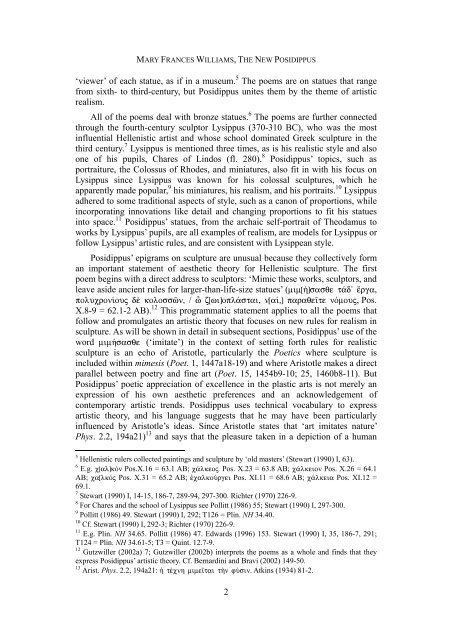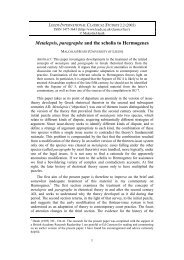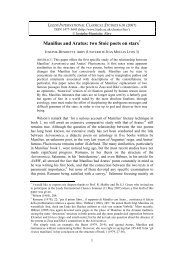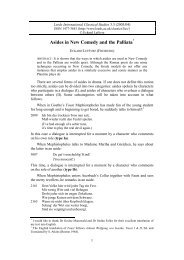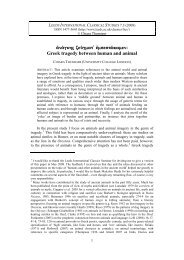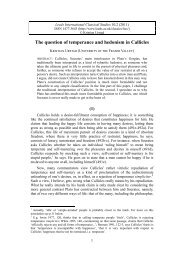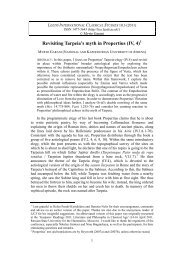The New Posidippus - Leeds International Classical Studies
The New Posidippus - Leeds International Classical Studies
The New Posidippus - Leeds International Classical Studies
You also want an ePaper? Increase the reach of your titles
YUMPU automatically turns print PDFs into web optimized ePapers that Google loves.
MARY FRANCES WILLIAMS, THE NEW POSIDIPPUS<br />
‘viewer’ of each statue, as if in a museum. 5 <strong>The</strong> poems are on statues that range<br />
from sixth- to third-century, but <strong>Posidippus</strong> unites them by the theme of artistic<br />
realism.<br />
All of the poems deal with bronze statues. 6 <strong>The</strong> poems are further connected<br />
through the fourth-century sculptor Lysippus (370-310 BC), who was the most<br />
influential Hellenistic artist and whose school dominated Greek sculpture in the<br />
third century. 7 Lysippus is mentioned three times, as is his realistic style and also<br />
one of his pupils, Chares of Lindos (fl. 280). 8 <strong>Posidippus</strong>’ topics, such as<br />
portraiture, the Colossus of Rhodes, and miniatures, also fit in with his focus on<br />
Lysippus since Lysippus was known for his colossal sculptures, which he<br />
apparently made popular, 9 his miniatures, his realism, and his portraits. 10 Lysippus<br />
adhered to some traditional aspects of style, such as a canon of proportions, while<br />
incorporating innovations like detail and changing proportions to fit his statues<br />
into space. 11 <strong>Posidippus</strong>’ statues, from the archaic self-portrait of <strong>The</strong>odamus to<br />
works by Lysippus’ pupils, are all examples of realism, are models for Lysippus or<br />
follow Lysippus’ artistic rules, and are consistent with Lysippean style.<br />
<strong>Posidippus</strong>’ epigrams on sculpture are unusual because they collectively form<br />
an important statement of aesthetic theory for Hellenistic sculpture. <strong>The</strong> first<br />
poem begins with a direct address to sculptors: ‘Mimic these works, sculptors, and<br />
leave aside ancient rules for larger-than-life-size statues’ (mim[»]sasqe t£d' œrga,<br />
polucron…ouj d kolossîn, / ð z[wi]opl£stai, n[a…,] paraqe‹te nÒmouj, Pos.<br />
X.8-9 = 62.1-2 AB). 12 This programmatic statement applies to all the poems that<br />
follow and promulgates an artistic theory that focuses on new rules for realism in<br />
sculpture. As will be shown in detail in subsequent sections, <strong>Posidippus</strong>’ use of the<br />
word mim»sasqe (‘imitate’) in the context of setting forth rules for realistic<br />
sculpture is an echo of Aristotle, particularly the Poetics where sculpture is<br />
included within mimesis (Poet. 1, 1447a18-19) and where Aristotle makes a direct<br />
parallel between poetry and fine art (Poet. 15, 1454b9-10; 25, 1460b8-11). But<br />
<strong>Posidippus</strong>’ poetic appreciation of excellence in the plastic arts is not merely an<br />
expression of his own aesthetic preferences and an acknowledgement of<br />
contemporary artistic trends. <strong>Posidippus</strong> uses technical vocabulary to express<br />
artistic theory, and his language suggests that he may have been particularly<br />
influenced by Aristotle’s ideas. Since Aristotle states that ‘art imitates nature’<br />
Phys. 2.2, 194a21) 13 and says that the pleasure taken in a depiction of a human<br />
5<br />
Hellenistic rulers collected paintings and sculpture by ‘old masters’ (Stewart (1990) I, 63).<br />
6<br />
E.g. c[al]kÒn Pos.X.16 = 63.1 AB; c£lkeoj Pos. X.23 = 63.8 AB; c£lkeion Pos. X.26 = 64.1<br />
AB; ca[lkÒj Pos. X.31 = 65.2 AB; calkoÚrgei Pos. XI.11 = 68.6 AB; c£lkeia Pos. XI.12 =<br />
69.1.<br />
7<br />
Stewart (1990) I, 14-15, 186-7, 289-94, 297-300. Richter (1970) 226-9.<br />
8<br />
For Chares and the school of Lysippus see Pollitt (1986) 55; Stewart (1990) I, 297-300.<br />
9<br />
Pollitt (1986) 49. Stewart (1990) I, 292; T126 = Plin. NH 34.40.<br />
10<br />
Cf. Stewart (1990) I, 292-3; Richter (1970) 226-9.<br />
11<br />
E.g. Plin. NH 34.65. Pollitt (1986) 47. Edwards (1996) 153. Stewart (1990) I, 35, 186-7, 291;<br />
T124 = Plin. NH 34.61-5; T3 = Quint. 12.7-9.<br />
12<br />
Gutzwiller (2002a) 7; Gutzwiller (2002b) interprets the poems as a whole and finds that they<br />
express <strong>Posidippus</strong>’ artistic theory. Cf. Bernardini and Bravi (2002) 149-50.<br />
13<br />
Arist. Phys. 2.2, 194a21: ¹ tšcnh mime‹tai t¾n fÚsin. Atkins (1934) 81-2.<br />
2


